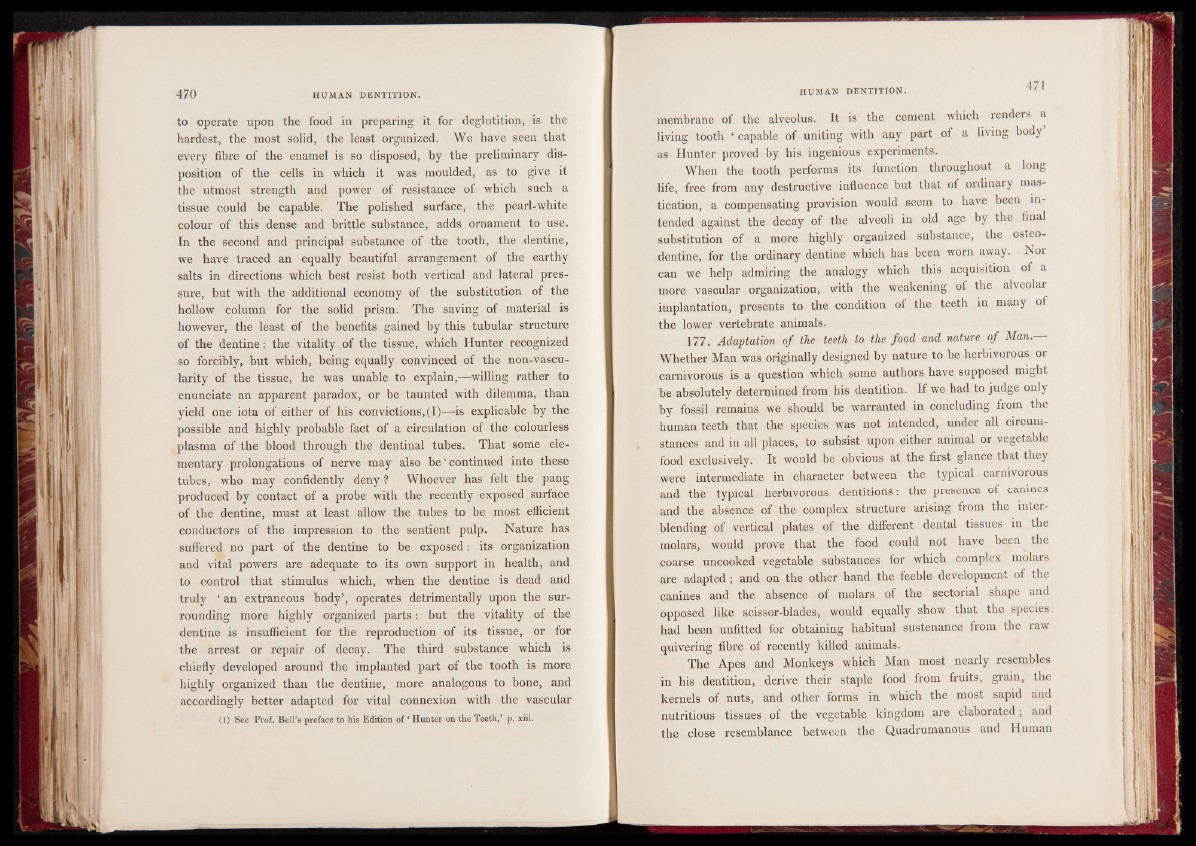
470 HUMAN DENTITION.
to operate upon the food in preparing it for deglutition, is the
hardest, the most solid, the least organized. We have seen that
every fibre of the enamel is so disposed, by the preliminary disposition
of the cells in which it was moulded, as to give it
the utmost strength and power of resistance of which such a
tissue could be capable. The polished surface, the pearl-white
colour of this dense and brittle substance, adds ornament to use.
In the second and principal substance of the tooth, the dentine,
we have traced an equally beautiful arrangement of the earthy
salts in directions which best resist both vertical and lateral pressure,
but with the additional economy of the substitution of the
hollow column for the solid prism. The saving of material is
however, the least of the benefits gained by this tubular structure
of the dentine f the vitality of the tissue, which Hunter recognized
so forcibly, but which, being equally convinced of the non-vascu-
larity of the tissue, he was unable to explain,—willing rather to
enunciate an apparent paradox, or be taunted with dilemma, than
yield one iota of either of his convictions, (1)—is explicable by the
possible and highly probable fact of a circulation of the colourless
plasma of the blood through the dentinal tubes. That some elementary
prolongations of nerve may also be'continued into these
tubes, who may confidently deny ? Whoever has felt the pang
produced by contact of a probe with the recently exposed surface
of the dentine, must at least allow the tubes to be most efficient
conductors of the impression to the sentient pulp. Nature has
suffered no part of the dentine to be exposed: its organization
and vital powers are adequate to its own support in health, and
to control that stimulus which, when the dentine is dead and
truly i an extraneous body’, operates detrimentally upon the surrounding
more highly organized parts: but the vitality of the
dentine is insufficient for the reproduction of its tissue, or for
the arrest or repair of decay. The third substance which is
chiefly developed around the implanted part of the tooth is more
highly organized than the dentine, more analogous to bone, and
accordingly better adapted for vital connexion with the vascular
(1) See Prof. Bell’s preface to his Edition of ‘ Hunter on the Teeth,’ p. xiii.
HUMAN DENTITION.
membrane of the alveolus. It is the cement which renders a
living tooth ‘ capable of uniting with any part of a living body’
as Hunter proved by his ingenious experiments.
When the tooth performs its function throughout a long
life, free from any destructive influence but that of ordinary mastication,
a compensating provision would seem to have been intended
against the decay of the alveoli in old age by the final
substitution of a more highly organized substance, the osteo-
dentine, for the ordinary dentine which has been worn away. Nor
can we help admiring the analogy which this acquisition of a
more vascular organization, with the weakening of the alveolar
implantation, presents to the condition of the teeth in many of
the lower vertebrate animals.
177. Adaptation of the teeth to the food and nature of Man.—
Whether Man was originally designed by nature to be herbivorous or
carnivorous is a question which some authors have supposed might
be absolutely determined from his dentition. If we had to judge only
by fossil remains we should be warranted in concluding from the
human teeth that the species was not intended, under all circumstances
and in all places, to subsist upon either animal or vegetable
food exclusively. It would be obvious at the first glance that they
were intermediate in character between the typical carnivorous
and the typical herbivorous dentitions: the presence of canines
and the absence of the complex structure arising from the interblending
of vertical plates of the different dental tissues in the
molars, would prove that the food could not have been ^ the
coarse uncooked vegetable substances for which complex molars
are adapted; and on the other hand the feeble development of the
canines and the absence of molars of the sectorial shape and
opposed like scissor-blades, would equally show that the species,
had been unfitted for obtaining habitual sustenance from the raw
quivering fibre of recently killed animals.
The Apes and Monkeys which Man most nearly resembles
in his dentition, derive their staple food from fruits, grain, the
kernels of nuts, and other forms in which the most sapid and
nutritious tissues of the vegetable kingdom are elaborated; and
the close resemblance between the Quadrumanous and Human